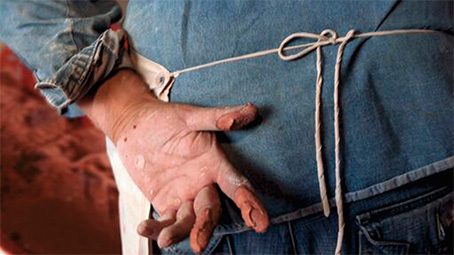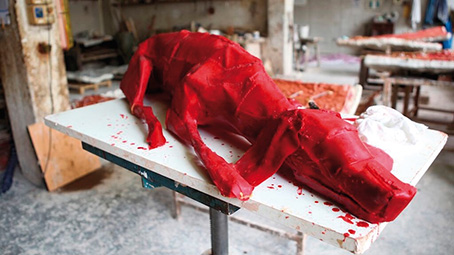|
Many of us, I'm guessing, still secretly harbour a somewhat stereotypical image of a sculptor as a robe-covered man chipping away at a stone block with a hammer and chisel, stepping back intermittently to survey his work and climbing a stepladder to reach the head of the oversized nude on which he is working. Sculpture has been traditionally viewed as a subtractive process involving the removal of unwanted material to reveal the beauty of the form that is hidden within. But what of the bronze figures you'll find on public display in any number of prominent landmarks in the western world? I'd like to see even the most muscular sculptor create one of them by chiselling away at a solid block of this hardy and resistant alloy.
Despite spending a couple of years at art school, it wasn't until I was commissioned to make a film about the creation of such a statue that I gave any real thought to work involved in its making. The job paid little and would clearly take some time, but I accepted it anyway, excited by the prospect of being able to follow such a process from conception to completion. Imagine my disappointment when the sculptor revealed that the work was almost complete, and that not only would I have to create the film from interviews and the artist's self-shot stills and low-band video, but that the finished film was to be screened at the unveiling ceremony in just four weeks' time. On the plus side I was encouraged to experiment with its form and play some colourful games with the supplied material, but I ultimately missed out on the chance to observe and record in detail the process of the statue's creation. Which is where first-time director Francesco Clerici's beguiling documentary Hand Gestures comes in.

The process known as lost wax casting was invented during what became known as the Bronze Age (a period covering roughly 3000-700 BC) and in spite of the technological advances in the centuries that followed, it has changed little since its inception and remains the default method for the creation of bronze sculptures. It's a process still used by the Fonderia Artistica Battaglia in Milan, one of the oldest and important artistic foundries still operating today.
If all this sounds like I really know my way around the Italian art scene then I should admit up front that I learned most of this from the captions that open this film. If you're fond of such textual clarification then savour your brief time with these as they're the last that you'll get. Hand Gestures is an observational documentary stripped to its essentials, a record of the process of creating a bronze sculpture using lost wax casting that is unassisted by captions, narration or interviews. And given that this is his first film, producer, director, writer, cinematographer and editor Francesco Clerici is taking a hell of a chance by opting for such a pared-down approach, providing no clarification on what the various artisans are doing at each stage of the process and inviting us to simply to watch them at work.
While in theory this should make for a somewhat academic film experience, the result is genuinely and unexpectedly mesmerising. By stripping away all other informational accessories, Clerici very effectively focuses our attention on the process and the meticulous work of the individual artists and craftsmen, to the point where I felt almost as if I had stepped into the film and was standing in the foundry alongside them as they went about their business paying me no heed. With no clarifying narration or spoken descriptions from the craftsmen themselves, I was initially a tad bemused by some aspects of the process and the role that they would later play, but figuring this out for myself soon became one of the film's principal pleasures.

There's a refreshing purity to the minimalism of Hand Gestures that made me realise how rarely a film allows us to just sit and watch something without feeling the need to sex up the visuals or pack the soundtrack with informative chat, a soundtrack that here consists solely of background voices and radio broadcasts, and the crisply recorded sounds of the tasks at hand. So effective is this and so much part of the film's fabric that when one of the craftsmen briefly comments on what he is doing, the spell is temporarily broken and I rather pompously found myself willing him back into silence. The longevity of the process, meanwhile, is illustrated by intercutting Clerici's record of the various stages of the operation with monochrome footage shot at Fonderia Artistica Battaglia in 1967 of the same, which rather neatly demonstrates how little has changed in the intervening years.
It all makes for one of the most unforced and entrancing film pleasures I've experienced so far this year. It helps, of course, that the lost wax process itself is so worthy of recording and communicating to the uninitiated in such detail, and in spite of its surface calm and unhurried pace, Clerici's varied camera angles (all of which are static and tripod mounted) and compression of action through editing give the storytelling an almost invisible briskness. The opening captions inform us that "the steps of this process are not taught in schools, but are passed on in the ancient oral tradition, watching and learning directly from the artisans." Well watch and learn, people. I certainly did.
Hand Gestures was screened at the 59th BFI London Film Festival on the following dates:
Friday 09 October 2015 15:45
BFI Southbank, NFT3
Saturday 10 October 2015 15:30
BFI Southbank, NFT2
The 59th BFI London Film Festival runs from 7th to 18th October 2015.
For further information on the films being screened and to buy tickets for showings, head here:
https://whatson.bfi.org.uk/lff/Online/
|